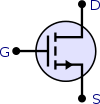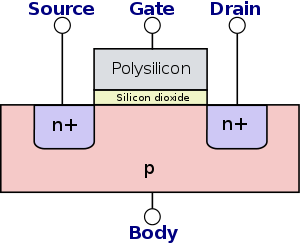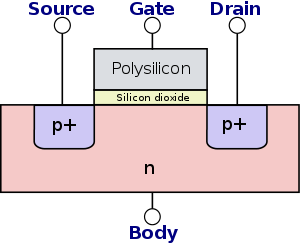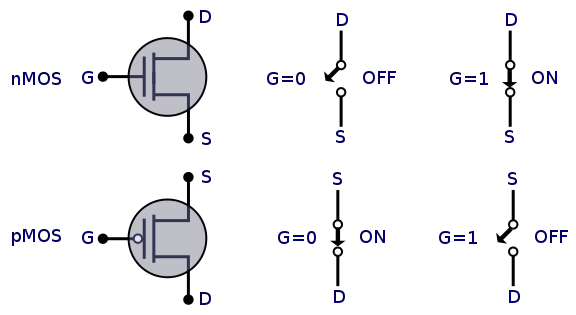| Line 2: | Line 2: | ||
'''MOSFET''' ('''Metal-Oxide-Semiconductor Field-Effect-Transistor'''), also known as the '''MOS transistor''' ('''metal–oxide–silicon transistor''') or '''IGFET''' ('''Insulated-Gate Field-Effect Transistor'''), is a type of insulated-gate [[field-effect transistor]] that is fabricated by the [[thermal oxidation|controlled oxidation]] of a [[semiconductor]] (typically [[silicon]]) and utilizes an insulator (such as [[wikipedia:Silicon dioxide|SiO<sub>2</sub>]]) between the gate and the body. Today, the MOSFET is the most common type of [[transistor]] for both digital and analog circuits. The voltage of the [[gate oxide|gate terminal]] determines the [[electrical conductivity]] of the device; this ability to change conductivity with the amount of applied voltage can be used for [[amplifier|amplifying]] or switching [[signal (electrical engineering)|electronic signals]]. | '''MOSFET''' ('''Metal-Oxide-Semiconductor Field-Effect-Transistor'''), also known as the '''MOS transistor''' ('''metal–oxide–silicon transistor''') or '''IGFET''' ('''Insulated-Gate Field-Effect Transistor'''), is a type of insulated-gate [[field-effect transistor]] that is fabricated by the [[thermal oxidation|controlled oxidation]] of a [[semiconductor]] (typically [[silicon]]) and utilizes an insulator (such as [[wikipedia:Silicon dioxide|SiO<sub>2</sub>]]) between the gate and the body. Today, the MOSFET is the most common type of [[transistor]] for both digital and analog circuits. The voltage of the [[gate oxide|gate terminal]] determines the [[electrical conductivity]] of the device; this ability to change conductivity with the amount of applied voltage can be used for [[amplifier|amplifying]] or switching [[signal (electrical engineering)|electronic signals]]. | ||
| − | The MOSFET was invented by [[Mohamed M. Atalla]] and [[Dawon Kahng]] at [[Bell Labs]] in 1959, and first presented in 1960. It is the basic building block of modern electronics, and the [[List of best-selling electronic devices|most frequently manufactured device]] in history, with an estimated total of 13 sextillion (10<sup>22</sup>) MOSFETs manufactured between 1960 and 2018.<ref>{{ | + | The MOSFET was invented by [[Mohamed M. Atalla]] and [[Dawon Kahng]] at [[Bell Labs]] in 1959, and first presented in 1960. It is the basic building block of modern electronics, and the [[List of best-selling electronic devices|most frequently manufactured device]] in history, with an estimated total of 13 sextillion (10<sup>22</sup>) MOSFETs manufactured between 1960 and 2018.<ref>{{Cite web|title=13 Sextillion & Counting: The Long & Winding Road to the Most Frequently Manufactured Human Artifact in History|url=https://computerhistory.org/blog/13-sextillion-counting-the-long-winding-road-to-the-most-frequently-manufactured-human-artifact-in-history/?key=13-sextillion-counting-the-long-winding-road-to-the-most-frequently-manufactured-human-artifact-in-history|last=Laws|first=David|date=April 2, 2018|website=Computer History Museum|access-date=May 5, 2020}}</ref> It is the dominant [[semiconductor device]] in [[Digital electronics|digital]] and [[Analogue electronics|analog]] [[integrated circuits]] (ICs),<ref name="Ashley" /> and the most common [[power device]].<ref name="aosmd" /> It is a compact [[transistor]] that has been miniaturised and mass-produced for a [[List of MOSFET applications|wide range of applications]], revolutionizing the [[electronics industry]] and the world economy, and being central to the [[digital revolution]], [[silicon age]] and [[information age]]. MOSFET scaling and miniaturization has been driving the rapid exponential growth of electronic semiconductor technology since the 1960s, and enables [[Very Large Scale Integration|high-density ICs]] such as [[memory chip]]s and [[microprocessors]]. |
A key advantage of a MOSFET is that it requires almost no input current to control the load current, when compared with [[bipolar junction transistors]] (BJTs). In an ''[[enhancement mode]]'' MOSFET, voltage applied to the gate terminal can increase the conductivity from the "normally off" state. In a ''[[depletion mode]]'' MOSFET, voltage applied at the gate can reduce the conductivity from the "normally on" state.<ref name="depletion">{{cite book |title=Electronic Circuits |chapter=§8.2 The depletion mode MOSFET |chapter-url=https://books.google.com/books?id=ggpVToC2obIC&pg=SA8-PA2|page=812 |first1=U. A. |last1=Bakshi |first2=A. P.|last2=Godse |isbn=978-81-8431-284-3 |year=2007 |publisher=Technical Publications}}</ref> MOSFETs are also capable of high scalability, with increasing [[miniaturization]], and can be easily scaled down to smaller dimensions. They also have faster switching speed (ideal for [[digital signal]]s), much smaller size, consume significantly less power, and allow much higher density (ideal for [[large-scale integration]]), compared to BJTs. MOSFETs are also cheaper and have relatively simple processing steps, resulting in high [[manufacturing yield]]. | A key advantage of a MOSFET is that it requires almost no input current to control the load current, when compared with [[bipolar junction transistors]] (BJTs). In an ''[[enhancement mode]]'' MOSFET, voltage applied to the gate terminal can increase the conductivity from the "normally off" state. In a ''[[depletion mode]]'' MOSFET, voltage applied at the gate can reduce the conductivity from the "normally on" state.<ref name="depletion">{{cite book |title=Electronic Circuits |chapter=§8.2 The depletion mode MOSFET |chapter-url=https://books.google.com/books?id=ggpVToC2obIC&pg=SA8-PA2|page=812 |first1=U. A. |last1=Bakshi |first2=A. P.|last2=Godse |isbn=978-81-8431-284-3 |year=2007 |publisher=Technical Publications}}</ref> MOSFETs are also capable of high scalability, with increasing [[miniaturization]], and can be easily scaled down to smaller dimensions. They also have faster switching speed (ideal for [[digital signal]]s), much smaller size, consume significantly less power, and allow much higher density (ideal for [[large-scale integration]]), compared to BJTs. MOSFETs are also cheaper and have relatively simple processing steps, resulting in high [[manufacturing yield]]. | ||
Revision as of 00:16, 6 September 2024

MOSFET (Metal-Oxide-Semiconductor Field-Effect-Transistor), also known as the MOS transistor (metal–oxide–silicon transistor) or IGFET (Insulated-Gate Field-Effect Transistor), is a type of insulated-gate field-effect transistor that is fabricated by the controlled oxidation of a semiconductor (typically silicon) and utilizes an insulator (such as SiO2) between the gate and the body. Today, the MOSFET is the most common type of transistor for both digital and analog circuits. The voltage of the gate terminal determines the electrical conductivity of the device; this ability to change conductivity with the amount of applied voltage can be used for amplifying or switching electronic signals.
The MOSFET was invented by Mohamed M. Atalla and Dawon Kahng at Bell Labs in 1959, and first presented in 1960. It is the basic building block of modern electronics, and the most frequently manufactured device in history, with an estimated total of 13 sextillion (1022) MOSFETs manufactured between 1960 and 2018.[1] It is the dominant semiconductor device in digital and analog integrated circuits (ICs),[2] and the most common power device.[3] It is a compact transistor that has been miniaturised and mass-produced for a wide range of applications, revolutionizing the electronics industry and the world economy, and being central to the digital revolution, silicon age and information age. MOSFET scaling and miniaturization has been driving the rapid exponential growth of electronic semiconductor technology since the 1960s, and enables high-density ICs such as memory chips and microprocessors.
A key advantage of a MOSFET is that it requires almost no input current to control the load current, when compared with bipolar junction transistors (BJTs). In an enhancement mode MOSFET, voltage applied to the gate terminal can increase the conductivity from the "normally off" state. In a depletion mode MOSFET, voltage applied at the gate can reduce the conductivity from the "normally on" state.[4] MOSFETs are also capable of high scalability, with increasing miniaturization, and can be easily scaled down to smaller dimensions. They also have faster switching speed (ideal for digital signals), much smaller size, consume significantly less power, and allow much higher density (ideal for large-scale integration), compared to BJTs. MOSFETs are also cheaper and have relatively simple processing steps, resulting in high manufacturing yield.
MOSFETs can either be manufactured as part of MOS integrated circuit chips or as discrete MOSFET devices (such as a power MOSFET), and can take the form of single-gate or multi-gate transistors. Since MOSFETs can be made with either p-type or n-type semiconductors (PMOS or NMOS logic, respectively), complementary pairs of MOSFETs can be used to make switching circuits with very low power consumption: CMOS (Complementary MOS) logic.
The name "metal–oxide–semiconductor" (MOS) typically refers to a metal gate, oxide insulation, and semiconductor (typically silicon).[5] However, the "metal" in the name MOSFET is sometimes a misnomer, because the gate material can also be a layer of polysilicon (polycrystalline silicon). Because originally the gate was made from metal, the name metal-oxide semiconductor (MOS) stuck, as today the gates are typically made of polycrystalline sillicon, although in recent years, advancements in technology reintroduced metallic gates in order to solve various performance issues. Along with oxide, different dielectric materials can also be used with the aim of obtaining strong channels with smaller applied voltages. The MOS capacitor is also part of the MOSFET structure.
Contents
Overview
Process
- Further information: doping, n-type semiconductor, and p-type semiconductor
The basic starting material for most integrated circuits based on MOSFET technology is typically Silicon (Si); though other processes such as silicon-germanium (Si1−xGex) also exist. Silicon is a very brittle metalloid. It has the same structure as a diamond in elemental form (the actual structure is a 3D tetrahedral, just like carbon). It's a Group IV element - each silicon forming single covalent bonds with four adjacent silicon atoms. Because all of its valence electrons are involved in chemical bonds, pure silicon is quite a poor conductor of electricity. It's possible to raise the conductivity of silicon by introducing impurities, known as dopants, into the silicon lattice through a processes known as doping. Similar results can also be achieved by adding group V elements (which have 5 bonding electrons vs 4 for Si) such as phosphorus or arsenic. By inserting those group V elements into the silicon lattice it can still bond to the 4 original silicon atoms neighbors. The 5th valence electron is loosely bound to that group V element. The thermal vibrations is enough make that electron free to move - leaving positive ions and a free electron. It is this free electron that can carry current thereby increasing the conductivity of the lattice. The process forms a new semiconductor called an n-type semiconductor. The processes can be done with a group III element as well. This creates a situation where each atom is now short by an electron. The missing electron (or hole) propagates about the lattice. The hole acts as a positive carrier gaining the name p-type semiconductor.
A diode is the junction between p-type semiconductors and n-type semiconductors. When the voltage on the p-type semiconductors, known as anode, is raised above the n-type semiconductors, known as a cathode, the diode is said to be forward biased. When that happens, current flows. When the anode voltage is equal to or less than the cathode voltage, the diode is reverse biased - at which point very little current flows. Varying the voltage between the gate and body modulates the conductivity of this layer effectively controlling the current flow between drain and source.
MOS sandwich-like structure is created by superimposing several layers of conducting and insulating together. The actual process involves oxidation of the silicon, doping of the silicon using dopants, and etching of metal wires and contacts. Transistors are built on a pure and flawless single crystals of silicon. Each transistor consists of a body - the silicon wafer. The body is often grounded, often considered the reference node. Each transistor has a stack of the conducting gate that sits on top of an isolating glass (SiO2), and the substrate (also known as the body).
An nMOS transistor is built with a p-type body with two regions of n-type semiconductor adjacent to the gate called the source and the drain. For all practical purposes they are physically equivalent and can be used interchangeably. A pMOS transistor is built with an n-type body with two regions of p-type semiconductors adjacent to the gate.
Controlling Gate
Both pMOS and nMOS have a controlling gate. The controlling gate, as the name implies, controls the flow of electrons between the source and drain.
nMOS gate behavior
- Main article: nMOS transistor
In the nMOS transistor, since the body is grounded, the p-n junctions of the source and drain to body are reverse-biased. If the voltage at the gate is raised, an electric field starts to build up - attracting free electrons to the underside of the Si-SiO2 interface. When the voltage is high enough, the electrons end up filling all the holes and a thin region under the gate called the channel gets inverted to act as an n-type semiconductor - creating a conducting path from the source to the drain, allowing current to flow. When the transistor is at that state, we say the transistor is ON. If the gate is grounded, little to no current flows through the reverse-biased junction. When that happens, we say the transistor is OFF.
pMOS gate behavior
- Main article: pMOS transistor
In the pMOS transistor, the behavior and setup is the complement of the nMOS transistor. The body is held at positive voltage. When the gate is also positive - the source and drain are reverse-biased. When that happens, no current flows and we say the transistor is OFF.
When the voltage at the gate is lowered, positive charges are attracted to the underside of the Si-SiO2 interface. When the voltage gets sufficiently low the channel gets inverted - creating a conducting path from the source to the drain, allowing current to flow. Because the behavior of a pMOS transistor is the opposite of that of an nMOS transistor, the symbol for pMOS transistor is identical to that of nMOS with an additional bubble on the gate. That bubble is known as an inversion bubble.
When dealing with digital logic there are generally only have two distinct values - ON and OFF, 1 and 0, or HIGH and LOW. The positive voltage of the transistor is called VDD (or POWER or PWR). VDD represents the logic 1 value in digital circuits. In TTL logic, the VDD voltage levels were usually around 5 volts. Today's transistors cannot really withstand such high voltages - they are typically in the 1.5V to 3.3V range. The low voltage is often called GROUND (or GND or VSS). VSS represents the logic 0. It is also normally set to 0 volts.
Modes of operation
| This section is empty; you can help add the missing info by editing this page. |
Symbols
There is no one standard that is commonly accepted across all organizations. Typically individual design groups adopt their own notations. Generally speaking, however, most follow the designs shown below which consists of a lone for the channel with the source and drain leaving it at right angles and then bending back at right angles outwards. Each device has a gate (G), drain (D), and a source (S), A distinction is sometimes made for enhancement mode where the channel is broken down into three smaller lines; it is sometimes drawn as a dotted line instead as well. Depletion mode devices have a solid line instead, this is due to the channel existing prior to power being applied.
Sometimes a fourth terminal for the body (B) is show. In discrete MOSFETs, the body lead is connected internally to the source. When that's the case, the body is also omitted from the symbol. When the bulk is shown, it is sometimes sometimes angled to meet up with the source. In ICs with a common bulk, the bulk is typically not shown and instead an inverting bubble is used to represent a PMOS.
| Channel | Depletion MOSFET | Enhancement MOSFT | ||
|---|---|---|---|---|
| W/ bulk | W/O bulk | W/ bulk | W/O bulk | |
| N-type |  |
 |
 |

|
 |
 |

| ||
| P-type |  |
 |
 |

|
 |
 |

| ||
See also
References
- ↑ Template:Cite web
- ↑ Cite error: Invalid
<ref>tag; no text was provided for refs namedAshley - ↑ Cite error: Invalid
<ref>tag; no text was provided for refs namedaosmd - ↑ (2007) "§8.2 The depletion mode MOSFET", Electronic Circuits. Technical Publications, 812. ISBN 978-81-8431-284-3.
- ↑ Cite error: Invalid
<ref>tag; no text was provided for refs namedcomputerhistory-transistor


